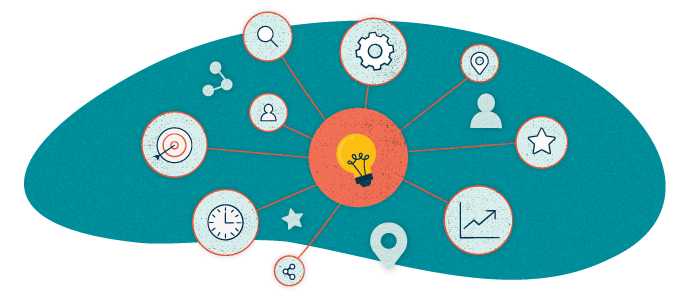Oh no, employee turnover.
The periodical mass exodus can erode any company’s growth and success from the inside. What can be done by employers to reduce worker turnover and cut costs?
Thankfully, a lot.
In the fast-paced world of modern business, employee turnover can often resemble a relentless tide, destroying hard-earned progress, disrupting the foundation of success, and agonizing HR managers and executives throughout every sector.
The financial toll of staff turnover is a daunting challenge for organizations across all industries.
The financial toll of employee turnover is a formidable challenge for organizations across industries. As the old Henry Ford adage goes, “The only thing worse than training your employees and having them leave is not training them and having them stay.”
It's a dilemma that leaves many leaders grappling with a pressing question: How can businesses mitigate the cost of employee turnover and foster a loyal, engaged workforce?
Reducing employee turnover is especially important in 2023 where remote work is at unprecedented highs making employee’s geographical locations redundant across various sectors.
Gartner, an IT research and consulting firm, estimates the business sector could see a turnover rate as high as 24% throughout the rest of 2023 in the United States, citing the main reason of employees feeling “disrespected at work.”
Forbes says a positive work environment can boost productivity and attract top-tier employees and keep them around longer compares to other companies who do not prioritize company culture.
Perhaps more importantly, Forbes points out that studies have concluded businesses with “highly engaged” employees can result in a higher profitability of 21%.
Today, we’re going to give, execs, HR managers, and any other leaders focused on staff retention several strategies to reduce employee turnover, offering a beacon of hope in the sea of staff uncertainty.
The Importance of Reducing Employee Turnover: Insights from Experts
Before we take a deep dive into strategies, it’s important to hear the voices of experts who emphasize the critical importance of how to reduce employee turnover— and who have dealt with staff turnover regularly.
HR experts agree that employee turnover isn’t just a revolving door, but a permanent problem that can lead to a loss of productivity, team dynamic disruption, and increased recruitment costs.
Beyond financial metrics, it erodes organizational cohesion and can dilute the very culture that is supposed to define a company.
Sound too familiar?
You’re not alone.
A survey conducted by ASAE and Avenue M Group, an association of executives and HR professionals, concluded that the “Great Resignation” was still an issue in 2023, with a majority of businesses reporting double-digit turnover rates in both 2022 and 2023.
To understand the factors that prompt employees to leave, Amanda Haddaway, the Managing Director of HR at Answerbox says employers should use “at least two methods to surface potential concerns” regarding losing employees.
One, she says, is engagement or pulse surveys—which focus on an organization’s culture, compensation, benefits, recognition, and much more. The HR expert advises that surveys should be brief but consistent.
“It’s not something you do one time a year, or one time every couple [of years],” she says. “You’re checking on the organization and its culture to address issues before they become catastrophic.”
Haddaway also advises supervisors to conduct what she calls “stay interviews” with key employees. A contrast to exit interviews, “stay interviews” are designed to air out concerns and encourage employees to stay on the job.
“You’ll ask them things like, ‘What’s going well for you? What challenges are you experiencing that I can help you with as your manager?’” she said. “If you’re feeling really brave, you can ask, ‘What would prompt you to leave the association?’”
The HR expert says she encourages managers to have “at least monthly one-on-one meetings to talk uninterrupted about those top-of-mind issues.” She continues, “The really astute supervisors are the ones who can sneak in those stay interview questions as a part of that one-on-one conversation.”
Haddaway admits that successful employers are ones who “increasingly managing the whole person,” addressing concerns about an employee’s mental health, overall well-being, and their psychological safety. “They’re finally realizing that employees have whole other lives outside the workplace,” she concludes. “We are whole humans, and need to be managed as such.”
Financially, the cost strain caused by employee turnover is a big concern.
According to the expert study “To Have and to Hold” by the Society for Human Resource Management (SHRM), the business ramifications are “enormous.”
Each employee departure costs about “one-third of that worker's annual earnings,” including recruiter fees expenses, temporary replacement workers, and lost productivity.
So, how can you create an environment and philosophy where employees want to work and feel valued? We’ll get there.
But first, we want to unravel the causes of why employee turnover is so prevalent.
Unraveling the Threads: What Causes Employee Turnover?
To effectively address a challenge, leaders, HR professionals, and execs must first understand its root causes. Employee turnover is no exception.
There are a multitude of factors that can contribute to the decision of an employee to seek opportunities elsewhere. At its core, turnover often stems from a misalignment between an individual's expectations and the realities of their role or work environment.
This misalignment can manifest in various ways, including:
- Lack of Recognition and Appreciation: Employees who feel undervalued and unappreciated are more likely to seek recognition and validation somewhere else.
- Limited Growth Opportunities: Stagnation can be demotivating. When employees perceive a lack of opportunities for growth and advancement, they are prone to seek greener pastures.
- Work-Life Imbalance: Balancing professional and personal responsibilities is a delicate act. Organizations that fail to support employees in achieving this balance risk high turnover rates.
- Dissatisfaction with Compensation: A fair and competitive compensation package is a cornerstone of almost all employee satisfaction. When compensation falls short of expectations, employees may explore alternatives.
- Inadequate Work Environment: A toxic or unstimulating work environment can prompt employees to seek an environment that nurtures their well-being and professional fulfillment.
- Lack of Respect and Inclusion: A culture that neglects diversity, equity, and inclusion can alienate employees and drive them towards more inclusive workplaces.
- Poor Management and Leadership: The role of a manager is pivotal in an employee's experience. Ineffective management can lead to disengagement and eventual departure.
- Unclear Expectations and Role Ambiguity: When employees are uncertain about their roles and responsibilities, frustration can mount, prompting them to explore clearer avenues.
 11 Strategies to Reduce Employee Turnover: Your Path to Progress
11 Strategies to Reduce Employee Turnover: Your Path to Progress
If you’re an executive, HR professional, or leader of a smaller business looking to retain staff better, there are solutions.
Put simply enough, work should be rewarding, fulfilling, and overall enjoyable. Obviously, there’s no one-stop solution to make employees love coming to work every day.
It’s a strategy that needs constant refinement and work. But you can do it.
We’re happy to provide some useful tips and strategies to help convince decision-makers of the need for employee retention strategies (and some relatable software that can be helpful).
Let’s have at it.
Keep in mind, these are not fleeting tactics. We’re focusing on time-tested approaches that will address the heart of the problem. From fostering a culture of recognition to promoting work-life balance, each strategy is a piece of the puzzle that contributes to retention mastery.
Here are 11 strategies that can help turn the tide and reduce employee turnover.
1. Fostering a Culture of Recognition: Fueling Loyalty
At the heart of reducing employee turnover lies the power of recognition.
In a world where employees increasingly seek more than just a paycheck, acknowledgment of their efforts and contributions resonates deeply. By implementing a comprehensive employee recognition program, organizations can create a culture that thrives on appreciation. Recognizing achievements—both big and small—sends a powerful message; that every individual's efforts are valued and vital to the company's success. The resulting boost in morale and engagement acts as a fortress against the tide of turnover, anchoring employees to a workplace where their contributions are celebrated.
The keyword here: “Acknowledgement.” When employees feel valued and recognized, they’ll feel more inclined to deliver for the team.
2. Crafting a Clear Path for Growth: Nurturing Long-Term Commitment
Employees yearn for growth and development, not just in terms of skills, but also in their career trajectories.
A well-defined path for advancement within the organization is a beacon that keeps turnover at bay. By outlining clear opportunities for growth, organizations signal that commitment and dedication will be rewarded with meaningful progression. Investing in professional development, mentoring programs, and continuous learning initiatives not only enhance employee skills but also foster a sense of loyalty and belonging.
The keyword here: “Potential.” When employees see a future brimming with possibilities, they're more likely to stay and explore the horizon within the organization.
3. Striking a Balance: Work-Life Harmony
The modern workplace is a dynamic ecosystem that extends well beyond office walls.
Employees crave a balance that harmonizes work with life's other facets. Organizations that recognize and support this yearning stand to gain a competitive edge in the battle against turnover.
Flexible work arrangements, remote options, and comprehensive leave policies demonstrate a genuine concern for employee well-being. When individuals can juggle their professional responsibilities with personal needs, job satisfaction flourishes.
The keyword here: "Harmony." By harmonizing work and life, businesses create an environment where employees don't feel torn between competing priorities, reducing the temptation to seek employment elsewhere.
4. Cultivating Respect: A Magnetic Work Environment
Respect is the foundation upon which lasting relationships are built (not just in the business world…)
The workplace is no exception.
Creating a respectful and inclusive environment is instrumental in reducing employee turnover. When individuals feel valued and respected, they are more likely to remain committed to their roles and the organization. Implementing anti-discrimination policies, fostering open communication, and prioritizing diversity and inclusion efforts send a resounding message – that every voice matters and contributes to collective success.
The keyword here: "Respect." Organizations that cultivate respect as a cornerstone of their culture not only retain employees but also foster an atmosphere of collaboration and innovation.
5. Data-Driven Insights: Guiding Retention Efforts
In an era dominated by data, leveraging analytics is a strategic move to combat turnover.
Harnessing the power of data-driven insights allows organizations to identify patterns, pinpoint areas of concern, and proactively address issues before they escalate.
By continuously monitoring key metrics related to turnover, engagement, and satisfaction, organizations gain a holistic view of their workforce's health.
(We’ll focus a bit more on software and apps that HR professionals and execs can use a little bit later on.)
The keyword here: "Insights." Armed with data-driven insights, organizations can make informed decisions, fine-tuning their strategies and initiatives to reduce employee turnover effectively.
6. Employee Well-Being: Nurturing the Whole Person
Employee well-being is not confined to physical health; it encompasses mental, emotional, and social aspects as well.
Organizations that prioritize well-being create an ecosystem where individuals thrive, leading to lower turnover rates. Initiatives such as wellness programs, mental health support, and employee assistance services are investments that yield returns in the form of increased loyalty and commitment. When employees feel supported and cared for, they are more likely to remain dedicated to their roles and contribute positively to the organization's growth.
The keyword here: "Well-being." Organizations that champion holistic well-being create an environment where employees flourish, resulting in reduced turnover.
7. Embracing Flexibility: Adapting to Change
In a landscape marked by rapid change, organizational flexibility is a key asset in the quest to reduce employee turnover. Flexibility extends beyond work hours and location; it encompasses adaptability in roles and responsibilities. Organizations that embrace flexibility empower employees to navigate evolving circumstances without feeling trapped. This empowerment fosters a sense of autonomy and control, reducing the desire to seek opportunities elsewhere. By valuing flexibility as a strategic advantage, organizations retain their most valuable asset – a committed and resilient workforce.
8. Navigating the Continuous Feedback Loop: Open Channels of Communication
Feedback is a powerful catalyst for growth. Organizations that establish open channels of communication create an environment where employees are heard, acknowledged, and empowered to share their perspectives. Regular check-ins, pulse surveys, and feedback mechanisms dismantle barriers, fostering transparency and trust.
The keyword here: "Communication." By fostering a culture of continuous feedback, organizations signal a commitment to improvement and growth, reducing the likelihood of employee turnover fueled by unresolved concerns.
9. Celebrating Diversity and Inclusion: A Tapestry of Unity
The symphony of employee retention is harmonized by the threads of diversity and inclusion.
Organizations that celebrate diversity create an environment where every individual feels welcomed and valued, irrespective of background or identity.
Inclusion goes beyond mere representation; it involves integrating diverse voices into decision-making and problem-solving processes.
The keyword here: "Unity." When employees sense that their uniqueness is an asset and their contributions are integral to the organization's fabric, they form bonds that withstand the currents of turnover.
10. Investing in Leadership Development: Guiding Lights
Leaders are the architects of an organization's culture and direction.
Investing in strong leadership development equips managers with the skills and acumen to nurture engaged and motivated teams.
Effective leaders understand the nuances of employee needs, aspirations, and challenges, fostering an environment where employees feel supported and valued.
The keyword here: "Guidance." When leaders serve as guiding lights, employees are more likely to navigate their journey within the organization, reducing the inclination to seek guidance elsewhere.
11. Grooming In-House Talent: A Tale of Growth
Internal promotions are a testament to an organization's commitment to nurturing talent from within.
When employees witness colleagues ascending the ladder of success, they perceive a clear path for their own growth. Organizations that prioritize internal promotions communicate that loyalty and dedication are valued and rewarded.
The keyword here: "Growth." By grooming in-house talent, organizations not only retain valuable employees but also foster a culture of aspiration and progress, where success stories inspire others to stay and thrive.
 Types of HR Software that Can Reduce Employee Turnover
Types of HR Software that Can Reduce Employee Turnover
Look, it’s 2023.
There is software and apps for pretty much everything. And employee retention effort software is no different.
There are several software solutions available that can significantly contribute to employee retention. These tools are designed to enhance communication, engagement, and overall employee experience, ultimately leading to higher retention rates.
We’re highlighting a few types of software that can be beneficial:
- Employee Recognition Software: This type of software— like the one offered by Applauz— offers employees a dedicated space to support and encourage each other’s achievements and contributions. It fosters a culture of appreciation and helps employees feel valued, which can boost morale and job satisfaction, leading to higher retention.
- Cloud-Based HR Systems: An HR system integrated with finance, CRM, and project management tools can bring all necessary data together in one place to help analyze talent trends, track performance, and find relevant training programs.
- Learning and Development Platforms: Providing employees with opportunities for skill development and growth is a powerful retention strategy. Learning management systems (LMS) and e-learning platforms offer personalized training, upskilling, and professional development opportunities, making employees more invested in their roles and less likely to seek opportunities elsewhere.
- Wellness and Well-being Apps: Employee well-being is closely tied to retention. Wellness platforms offer resources and tools to support employees' physical, mental, and emotional well-being. These apps can provide fitness challenges, stress management techniques, mental health support, and more, contributing to a healthier and more engaged workforce.
- Communication and Collaboration Tools: Seamless communication and collaboration are essential for employee engagement and satisfaction. Platforms like Slack, Microsoft Teams, Zoom, or similar tools facilitate real-time communication, remote collaboration, and knowledge sharing, fostering a sense of belonging and reducing feelings of isolation.
- Feedback and Survey Platforms: Regularly collecting feedback from employees through surveys and feedback platforms helps organizations identify areas for improvement and address concerns. By involving employees in decision-making processes and demonstrating a commitment to their input, organizations can boost morale and retention.
- Employee Onboarding Software: Effective onboarding plays a crucial role in setting the tone for an employee's experience. Onboarding software streamlines the process, ensures consistent training, and helps new hires feel welcomed and supported from day one, increasing their likelihood of staying with the organization.
 Conclusion: Anchoring Loyalty through Employee Recognition
Conclusion: Anchoring Loyalty through Employee Recognition
As the curtain falls on this exploration of strategies to reduce employee turnover, a resounding theme emerges: employee recognition is the lodestar that guides organizations toward retention excellence. Every strategy we’ve discussed today, from fostering a culture of recognition to championing work-life integration, finds its nexus in the power of acknowledgment and appreciation. When employees feel valued, recognized, and empowered, they are more likely to forge enduring connections with their roles and the organization. The symphony of strategies, harmonizing culture, growth, and well-being, contributes to the grand tapestry of employee retention.
The journey to reduce employee turnover is not a solitary one; it's a collaborative effort that involves leaders, managers, and employees at all levels.
By embracing these strategies, organizations embark on a path of transformation, where turnover gives way to loyalty, and uncertainty yields to commitment. As the tides of change continue to shape the business landscape, organizations that prioritize reducing employee turnover stand poised to navigate the currents with strength, resilience, and growth.
Frequently Asked Questions
How do you reduce staff turnover?
Reduce your employee turnover with strategies like competitive compensation, work-life balance, recognition programs, career development, and regular communication.
How can leaders reduce turnover?
Leaders can reduce turnover by fostering a positive work culture, offering growth opportunities, recognizing achievements, ensuring fair compensation, and promoting open communication.
How do you reduce employee turnover in healthcare?
Healthcare is a high-stakes industry where employee turnover can impact patient care and operational efficiency. To reduce turnover, healthcare organizations can implement robust training programs, prioritize employee well-being, and offer opportunities for advancement within the medical field.
How do you reduce employee turnover in manufacturing?
In the manufacturing sector, turnover can disrupt production and strain operational continuity. Strategies include investing in employee training and upskilling, creating a safe and supportive work environment, and providing clear pathways for career growth within the manufacturing industry.
How do you reduce employee turnover in retail?
Retail is marked by dynamic shifts and seasonal demands. To reduce turnover, retailers can focus on employee engagement through recognition, offer competitive compensation and benefits, and provide flexible scheduling options to accommodate the ebb and flow of retail cycles.
How do you reduce employee turnover in restaurants?
In the restaurant industry, turnover is a perennial challenge. To address this, restaurants can prioritize creating a positive work culture, offer opportunities for skill development, provide consistent feedback, and implement fair scheduling practices to enhance work-life balance. Because the restaurant industry is so interconnected, offer staff perks and rebates at nearby restaurants to create a strong neighborly culture.
About the author
Tyler Jadah
Tyler is a freelance writer focused on subjects like talent management, employee retention, and leadership development. Tyler delivers practical advice to help businesses cultivate motivated and high-performing teams.



